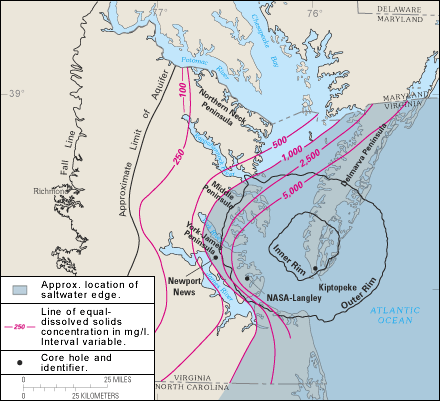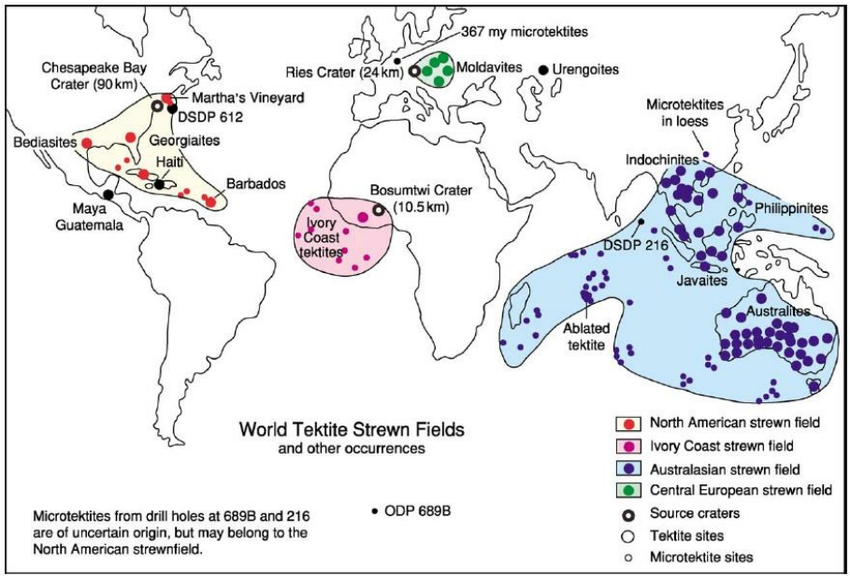It looks like you're using an Ad Blocker.
Please white-list or disable AboveTopSecret.com in your ad-blocking tool.
Thank you.
Some features of ATS will be disabled while you continue to use an ad-blocker.
share:
originally posted by: wildespace
I had the opportunity to visit one of the impact craters on Earth - the Kaali crater in Estonia.
Besides it being very cool to see an actual impact crater with your eyes, this crater is notable in that it's one of the most recent impact event that left a crater - it occured a few thousand years ago and there were people living in that area.
Looks like a mud pit. If that's what one can look like, they can be all over the place.
Neat HA ? BTW earth has been hit just as much and any planet in the system but as a few have alreday poijnted out Nature is one heck of a plastic
surgeon wind water teh plates moving why in as shot as a million years she has repaired all creator signs .
For ever confirmed creator on earth you can safely assume there is a 1000 we will never know about . The solar system is a shooting gallery we have been lucky as the shooters have taken off the last 80 years .
The next Impact is not a question of if but when and were again we have had a few years grace .
One day it could be new york or or or .
For ever confirmed creator on earth you can safely assume there is a 1000 we will never know about . The solar system is a shooting gallery we have been lucky as the shooters have taken off the last 80 years .
The next Impact is not a question of if but when and were again we have had a few years grace .
One day it could be new york or or or .
one other thing the longer earth sticks around the less impacts there will be again as others have pointed out .
each impact is one less rock and one day maybe a billion years from now there will be no rocks left to cross earths path .
In the mean time keep your umbrella handy I hear they are calling for a rain of rocks .
each impact is one less rock and one day maybe a billion years from now there will be no rocks left to cross earths path .
In the mean time keep your umbrella handy I hear they are calling for a rain of rocks .
a reply to: midnightstar
Very true!
Im all for rock (and roll) but a shower of bus sized rocks is not on my list of fun to-do's!
Very true!
Im all for rock (and roll) but a shower of bus sized rocks is not on my list of fun to-do's!
originally posted by: blackcrowe
a reply to: wildespace
That's cool.
a more recent event was the Tunguska event. 110 years
'It is estimated the asteroid entered Earth's atmosphere traveling at a speed of about 33,500 miles per hour. During its quick plunge, the 220-million-pound space rock heated the air surrounding it to 44,500 degrees Fahrenheit. At 7:17 a.m. (local Siberia time), at a height of about 28,000 feet, the combination of pressure and heat caused the asteroid to fragment and annihilate itself, producing a fireball and releasing energy equivalent to about 185 Hiroshima bombs.
"That is why there is no impact crater," said Yeomans. "The great majority of the asteroid is consumed in the explosion."'
Taken from this link. science.nasa.gov...
Probably a comet, then, made up of dust, small rocks, and ices. A solid rocky or metallic asteroid would have definitely left a crater.
a reply to: wildespace
Thanks wiildspace.
Perhaps you're right.
I highlighted the fact that not all space debris leaves an impact crater.
Although without the atmosphere. I think it would have impacted.
Thanks wiildspace.
Perhaps you're right.
I highlighted the fact that not all space debris leaves an impact crater.
Although without the atmosphere. I think it would have impacted.
The tunguska object was a cometary fragment, and shows us that "comets" are a diverse class of objects, who's composition can very wildly.
Tunguska left the mark of a comet in the greenland ice cores, while looking meteoric from the nickel enriched iron found at the site, yet leaves the chemistry of stony(chondritic) object.
Tunguska left the mark of a comet in the greenland ice cores, while looking meteoric from the nickel enriched iron found at the site, yet leaves the chemistry of stony(chondritic) object.
a reply to: CreationBro
I live on the edge of an ancient impact crater at the mouth of the Chesapeake bay.
I live on the edge of an ancient impact crater at the mouth of the Chesapeake bay.
a reply to: Sillyolme
He did forget the Chesapeake Bay crater,

Chesapeake Bay Impact Crater

I would argue it is not the largest crater in North America, that distinction belongs to the crater that we know as Saginaw Bay Mi.
Saginaw Bay Impact Crater
He did forget the Chesapeake Bay crater,

he bolide made impact at a speed of many kilometers per second, punching a deep hole through the sediments and into the granite continental basement rock. The bolide itself was completely vaporized, with the basement rock being fractured to depths of 8 km (5.0 mi), and a peak ring being raised around it. The deep crater, 38 km (24 mi) across, is surrounded by a flat-floored terrace-like ring trough with an outer edge of collapsed blocks forming ring faults.
The entire circular crater is about 85 km (53 mi) in diameter and 1.3 km (0.81 mi) deep, an area twice the size of Rhode Island, and nearly as deep as the Grand Canyon. However, numerical modeling techniques by Collins et al. indicate that the post-impact diameter was likely to have been around 40 km (25 mi), rather than the observed 85 km (53 mi).[3]
The surrounding region suffered massive devastation. USGS scientist David Powars, one of the impact crater's discoverers, has described the immediate aftermath: "Within minutes, millions of tons of water, sediment, and shattered rock were cast high into the atmosphere for hundreds of miles along the East Coast." An enormous tsunami engulfed the land and possibly even reached the Blue Ridge Mountains.[4] The sedimentary walls of the crater progressively slumped in, widened the crater, and formed a layer of huge blocks on the floor of the ring-like trough. The slump blocks were then covered with the rubble or breccia. The entire bolide event, from initial impact to the termination of breccia deposition, lasted only a few hours or days. In the perspective of geological time, the 1.2 km (0.75 mi) breccia is an instantaneous deposit. The crater was then buried by additional sedimentary beds that have accumulated during the 35 million years following the impact.
Chesapeake Bay Impact Crater

I would argue it is not the largest crater in North America, that distinction belongs to the crater that we know as Saginaw Bay Mi.
Saginaw Bay Impact Crater
new topics
-
President BIDEN's FBI Raided Donald Trump's Florida Home for OBAMA-NORTH KOREA Documents.
Political Conspiracies: 2 hours ago -
Maestro Benedetto
Literature: 3 hours ago -
Is AI Better Than the Hollywood Elite?
Movies: 4 hours ago -
Las Vegas UFO Spotting Teen Traumatized by Demon Creature in Backyard
Aliens and UFOs: 7 hours ago -
2024 Pigeon Forge Rod Run - On the Strip (Video made for you)
Automotive Discussion: 8 hours ago -
Gaza Terrorists Attack US Humanitarian Pier During Construction
Middle East Issues: 8 hours ago -
The functionality of boldening and italics is clunky and no post char limit warning?
ATS Freshman's Forum: 9 hours ago -
Meadows, Giuliani Among 11 Indicted in Arizona in Latest 2020 Election Subversion Case
Mainstream News: 10 hours ago -
Massachusetts Drag Queen Leads Young Kids in Free Palestine Chant
Social Issues and Civil Unrest: 10 hours ago -
Weinstein's conviction overturned
Mainstream News: 11 hours ago
top topics
-
President BIDEN's FBI Raided Donald Trump's Florida Home for OBAMA-NORTH KOREA Documents.
Political Conspiracies: 2 hours ago, 20 flags -
Krystalnacht on today's most elite Universities?
Social Issues and Civil Unrest: 13 hours ago, 9 flags -
University of Texas Instantly Shuts Down Anti Israel Protests
Education and Media: 16 hours ago, 8 flags -
Weinstein's conviction overturned
Mainstream News: 11 hours ago, 8 flags -
Supreme Court Oral Arguments 4.25.2024 - Are PRESIDENTS IMMUNE From Later Being Prosecuted.
Above Politics: 13 hours ago, 8 flags -
Massachusetts Drag Queen Leads Young Kids in Free Palestine Chant
Social Issues and Civil Unrest: 10 hours ago, 7 flags -
Gaza Terrorists Attack US Humanitarian Pier During Construction
Middle East Issues: 8 hours ago, 7 flags -
Las Vegas UFO Spotting Teen Traumatized by Demon Creature in Backyard
Aliens and UFOs: 7 hours ago, 6 flags -
Meadows, Giuliani Among 11 Indicted in Arizona in Latest 2020 Election Subversion Case
Mainstream News: 10 hours ago, 5 flags -
2024 Pigeon Forge Rod Run - On the Strip (Video made for you)
Automotive Discussion: 8 hours ago, 3 flags
active topics
-
VirginOfGrand says hello
Introductions • 9 • : TheMichiganSwampBuck -
President BIDEN's FBI Raided Donald Trump's Florida Home for OBAMA-NORTH KOREA Documents.
Political Conspiracies • 7 • : charlest2 -
Las Vegas UFO Spotting Teen Traumatized by Demon Creature in Backyard
Aliens and UFOs • 10 • : pianopraze -
Supreme Court Oral Arguments 4.25.2024 - Are PRESIDENTS IMMUNE From Later Being Prosecuted.
Above Politics • 84 • : Daughter2v2 -
Is AI Better Than the Hollywood Elite?
Movies • 12 • : rickymouse -
British TV Presenter Refuses To Use Guest's Preferred Pronouns
Education and Media • 170 • : Annee -
Massachusetts Drag Queen Leads Young Kids in Free Palestine Chant
Social Issues and Civil Unrest • 14 • : ToneD -
Sol Et Luna - TIME2024
Short Stories • 10 • : BrotherKinsMan -
University of Texas Instantly Shuts Down Anti Israel Protests
Education and Media • 263 • : cherokeetroy -
Gaza Terrorists Attack US Humanitarian Pier During Construction
Middle East Issues • 26 • : nugget1

